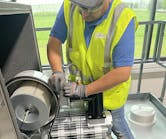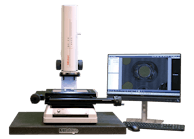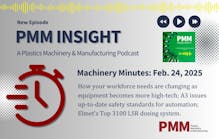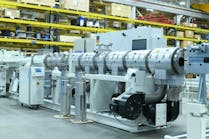By Bruce Geiselman
Epson recently developed a new six-axis robot capable of being mounted on an AMR (autonomous mobile robot) and increased the functionality of its new no-code, easy-to-use Epson RC+ Express software.
The company announced the new developments at a time when manufacturers increasingly are turning to robotics to help solve mounting challenges.
“Robotics and automation has been on a hot streak,” Aaron Donlon, an Epson product manager for robotics, told Plastics Machinery & Manufacturing. “It kind of already was even before COVID, as we were dealing with labor challenges and manufacturing challenges. Think of all the onshoring that’s going on right now. Think of all these people that are now, post-COVID, dealing with supply chain issues, whether it’s from factories overseas shutting down, whether managing their labor, or something else. There is really a ton more interest.”
Epson is seeing existing robotics customers invest in even more automation — doubling down on their investments — and it’s also seeing a lot of new users adopting robotics as well, Donlon said.
The company’s newest robot is a DC-powered version of the VT6L — the new VT6L-DC All-in-One six-axis robot that is designed for mobile applications. It allows a plastics manufacturer or other manufacturer to mount an industrial-grade six-axis robot to an AMR for warehousing applications or on a mobile platform to easily transport between workstations.
For example, an injection molder could use the VT6L-DC on an AMR for mobile machine tending.
“If you have a certain number of machines or machine cells but not all of them run continuously, if some of them are intermittent, you can mount the VT6L to a mobile platform and then you can move it to whichever machine needs tending or that load-unload process at any given time, so you don’t have robots sitting idle,” Danielle Collins, a product manager for Epson, told PMM. “You maximize your utilization.”
Unlike the previously introduced VT6L, the DC model is not tethered to a wall. The previous model runs off either 110- or 220-volt AC power.
The VT6L-DC comes with a built-in controller, a reach of up to 35.4 inches, and a payload of up to 13 pounds.
The company’s SlimLine Design features a compact wrist pitch, which enables access to hard-to-reach areas in confined spaces. An integrated vision guidance option makes it easy to automate simple applications when vision is required.
It is equipped with two programming tools — Epson RC+ for full-featured, easy-to-learn programming, and Epson RC+ Express for no-code programming.
The RC+ Express software is ideal for automation novices with little to no programming experience. It offers a simple, visual-based teaching environment, an easy-to-follow block-style format, and ready-to-use templates to get robots up and running quickly, according to the company.
When originally introduced about a year ago, RC+ Express software worked with about 25 of Epson’s four-axis SCARA robots. But its capabilities have now been expanded to work with hundreds of Epson robots, including its six-axis robots and the VT6L-DC. It also works with Epson’s high-performance G-, GX- and C-series, Donlon said.
New features include Point Management & Security, which makes it easy to manage and visualize points. The updated software’s Project Link enables robotic vision guidance, parts feeding and advanced applications, and connection with more robots opens up heavier tasks such as machine tending.
RC+ Express software uses a visual interface that makes it easy to learn and manage key functions like jogging, gripper control and motion. Common application templates are included for tasks such as pick-and-place, palletizing and depalletizing functions. A built-in 3D simulator lets an operator fine-tune applications before hardware setup. The software is compatible with touch-screen tablets in addition to PCs to easily create robot applications.
The software is included with the purchase of the robot and has no recurring licensing fees, which reduces total cost of ownership, and current users can update easily.
Bruce Geiselman, senior staff reporter
Epson Robots, Carson, Calif., 562-290-5910, www.epsonrobots.com
Bruce Geiselman | Senior Staff Reporter
Senior Staff Reporter Bruce Geiselman covers extrusion, blow molding, additive manufacturing, automation and end markets including automotive and packaging. He also writes features, including In Other Words and Problem Solved, for Plastics Machinery & Manufacturing, Plastics Recycling and The Journal of Blow Molding. He has extensive experience in daily and magazine journalism.
ABB appoints chief sales officer for B&R
KraussMaffei now building extruders in U.S.






